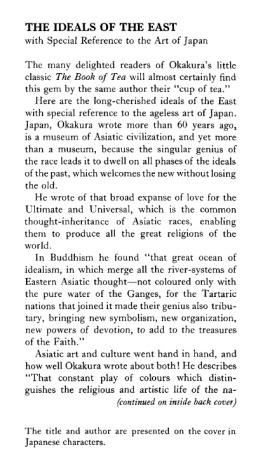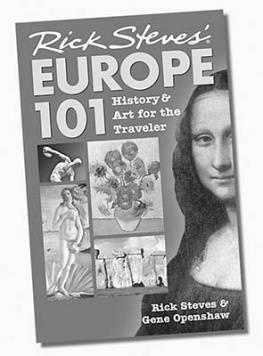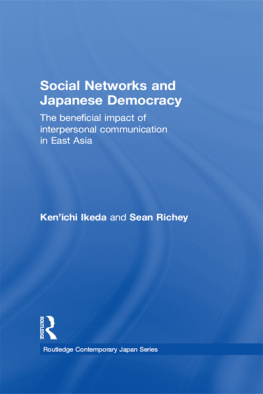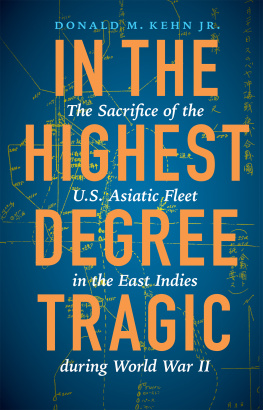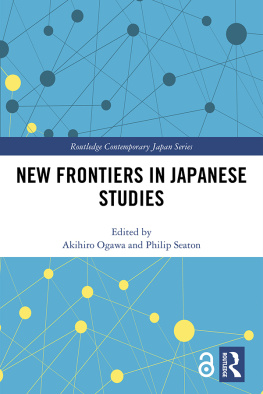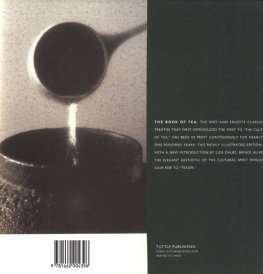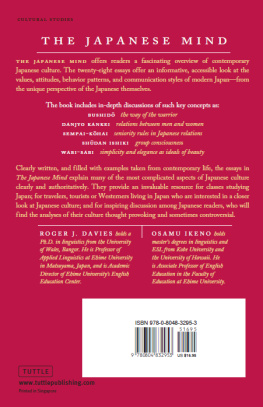
THE RANGE OF IDEALS
ASIA is one. The Himalayas divide, only to accentuate, two mighty civilisations, the Chinese with its communism of Confucius, and the Indian with its individualism of the Vedas. But not even the snowy barriers can interrupt for one moment that broad expanse of love for the Ultimate and Universal, which is the common thought-inheritance of every Asiatic race, enabling them to produce all the great religions of the world, and distinguishing them from those maritime peoples of the Mediterranean and the Baltic, who love to dwell on the Particular, and to search out the means, not the end, of life.
Down to the days of the Mohammedan conquest went, by the ancient highways of the sea, the intrepid mariners of the Bengal coast, founding their colonies in Ceylon, Java, and Sumatra, leaving Aryan blood to mingle with that of the sea-board races of Burmah and Siam, and binding Cathay and India fast in mutual intercourse.
The long systolic centuriesin which India, crippled in her power to give, shrank back upon herself, and China, self-absorbed in recovery from the shock of Mongol tyranny, lost her intellectual hospitality succeeded the epoch of Mahmoud of Ghazni, in the eleventh century. But the old energy of communication lived yet in the great moving sea of the Tartar hordes, whose waves recoiled from the long walls of the North, to break upon and overrun the Punjab. The Hunas, the Sakas, and the Gettaes, grim ancestors of the Rajputs, had been the forerunners of that great Mongol outburst which, under Genghis Khan and Tamerlane, spread over the Celestial soil, to deluge it with Bengali Tantrikism, and flooded the Indian peninsula, to tinge its Mussulman Imperialism with Mongolian polity and art.
For if Asia be one, it is also true that the Asiatic races form a single mighty web. We forget, in an age of classification, that types are after all but shining points of distinctness in an ocean of approximations, false gods deliberately set up to be worshipped, for the sake of mental convenience, but having no more ultimate or mutually exclusive validity than the separate existence of two interchangeable sciences. If the history of Delhi represents the Tartar's imposition of himself upon a Mohammedan world, it must also be remembered that the story of Baghdad and her great Saracenic culture is equally significant of the power of Semitic peoples to demonstrate Chinese, as well as Persian, civilisation and art, in face of the Frankish nations of the Mediterranean coast. Arab chivalry, Persian poetry, Chinese ethics, and Indian thought, all speak of a single ancient Asiatic peace, in which there grew up a common life, bearing in different regions different characteristic blossoms, but nowhere capable of a hard and fast dividing-line. Islam itself may be described as Confucianism on horseback, sword in hand. For it is quite possible to distinguish, in the hoary communism of the Yellow Valley, traces of a purely pastoral element, such as we see abstracted and self-realised in the Mussulman races.
Or, to turn again to Eastern Asia from the West, Buddhismthat great ocean of idealism, in which merge all the river-systems of Eastern Asiatic thoughtis not coloured only with the pure water of the Ganges, for the Tartaric nations that joined it made their genius also tributary, bringing new symbolism, new organisation, new powers of devotion, to add to the treasures of the Faith.
It has been, however, the great privilege of Japan to realise this unity-in-complexity with a special clearness. The Indo-Tartaric blood of this race was in itself a heritage which qualified it to imbibe from the two sources, and so mirror the whole of Asiatic consciousness. The unique blessing of unbroken sovereignty, the proud self-reliance of an un-conquered race, and the insular isolation which protected ancestral ideas and instincts at the cost of expansion, made Japan the real repository of the trust of Asiatic thought and culture. Dynastic upheavals, the inroads of Tartar horsemen, the carnage and devastation of infuriated mobsall these things, sweeping over her again and again, have left to China no landmarks, save her literature and her ruins, to recall the glory of the Tang emperors or the refinement of Sung society.
The grandeur of Asokaideal type of Asiatic monarchs, whose edicts dictated terms to the sovereigns of Antioeh and Alexandriais almost forgotten among the crumbling stones of Bharhut and Buddha Gaya. The jewelled court of Vikramaditya is but a lost dream, which even the poetry of Kalidasa fails to evoke. The sublime attainments of Indian art, almost effaced as they have been by the rough - handedness of the Hunas, the fanatical iconoclasm of the Mussulman, and the unconscious vandalism of mercenary Europe, leave us to seek only a past glory in the mouldy walls of Ajanta, the tortured sculptures of Ellora, the silent protests of rock-cut Orissa, and finally in the domestic utensils of the present day, where beauty clings sadly to religion in the midst of an exquisite home-life.
It is in Japan alone that the historic wealth of Asiatic culture can be consecutively studied through its treasured specimens. The Imperial collection, the Shinto temples, and the opened dolmens, reveal the subtle curves of Hng workmanship. The temples of Nara are rich in representations of Tng culture, and of that Indian art, then in its splendour, which so much influenced the creations of this classic period natural heir-looms of a nation which has preserved the music, pronunciation, ceremony, and costumes, not to speak of the religious rites and philosophy, of so remarkable an age, intact.
The treasure-stores of the daimyos, again, abound in works of art and manuscripts belonging to the Sung and Mongol dynasties, and as in China itself the former were lost during the Mongol conquest, and the latter in the age of the reactionary Ming, this fact animates some Chinese scholars of the present day to seek in Japan the fountain-head of their own ancient knowledge.
Thus Japan is a museum of Asiatic civilisation; and yet more than a museum, because the singular genius of the race leads it to dwell on all phases of the ideals of the past, in that spirit of living Advaitism which welcomes the new without losing the old. The Shinto still adheres to his pre-Buddhistic rites of ancestor - worship; and the Buddhists themselves cling to each various school of religious development which has come in its natural order to enrich the soil.
The Yamato poetry, and Bugaku music, which reflect the Tng ideal under the regime of the Fujiwara aristocracy, are a source of inspiration and delight to the present day, like the sombre Zennism and No-dances, which were the product of Sung illumination. It is this tenacity that keeps Japan true to the Asiatic soul even while it raises her to the rank of a modern power.
The history of Japanese art becomes thus the history of Asiatic idealsthe beach where each successive wave of Eastern thought has left its sand-ripple as it beat against the national consciousness. Yet I linger with dismay on the threshold of an attempt to make an intelligible summary of those art-ideals. For art, like the diamond net of Indra, reflects the whole chain in every link. It exists at no period in any final mould. It is always a growth, defying the dissecting knife of the chronologist. To discourse on a particular phase of its development means to deal with infinite causes and effects throughout its past and present. Art with us, as elsewhere, is the expression of the highest and noblest of our national culture, so that, in order to understand it, we must pass in review the various phases of Confucian philosophy; the different ideals which the Buddhist mind has from time to time revealed; those mighty political cycles which have one after another unfurled the banner of nationality; the reflection in patriotic thought of the lights of poetry and the shadows of heroic characters; and the echoes, alike of the wailing of a multitude, and of the mad-seeming merriment of the laughter of a race.

